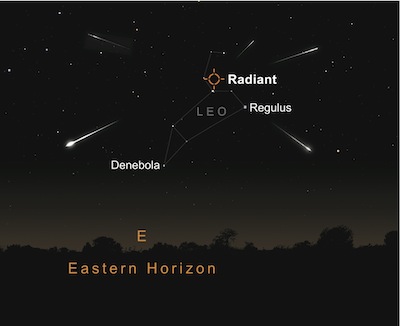
Catch the Leonids meteor shower this weekend
BY MARK ARMSTRONG
ASTRONOMY NOW
Posted: 14 November 2013

The Leonids meteor shower is predicted to peak on the night of 17/18 November around 7pm GMT. The Leonids are seen every year between November 15-20 as the Earth passes close to the descending node of the orbit of comet 55P/Tempel-Tuttle, the showers parent comet.

AN graphic by Greg Smye-Rumsby
In common with all comets, Tempel-Tuttle sheds a stream of small particles and meteoroids around the time it is closest to the Sun (perihelion) in its 33-year orbit. The Leonids was one of the highlights on the meteor calendar not so long ago, with the storm activity from 1999 (2500 meteors per hour were seen for an hour or so) to 2002 and anyone who witnessed the 'night of the fireballs' on 16/17 November 1998 will never forget it.
This storm and enhanced activity occurs for about five or so years either side of the comet's perihelion as most of the meteoroids are bunched up in a zone close to the comet. 55P/Tempel-Tuttle was last at perihelion in February 1998 with the next one not until 2031, so enhanced rates are not expected until the late 2020s. Of course there is a less-dense stream of material spaced out around the whole of the comet's orbit which produces the meteors we see every year.
This year we can expect around 20 meteors per hour at best but the radiant doesn't rise in the UK until after 11pm, four hours after the predicted peak; late-night watches are a necessity. The full Moon in Taurus will be a major headache for Leonids observers, its overpowering glow drowning out the fainter meteors. All is not lost though as Leonids often leave many persistent tracks or trains across the sky; Leonids are very fast meteors, with entry velocities of 70 kilometres per second.
The worst effects of the Moon can be minimised if your observing site has a wall, a building or something similar behind you, which can hide the Moon. As with observing any meteor shower the best advice is not to stare at the actual radiant but at an altitude of 50 degrees (about the same altitude of the Pole Star from the UK) and 30-40 degrees to one side of shower radiant (the width of a fist held at arm's length is about ten degrees). November nights can be bone-chilling so be well prepared, especially if you are travelling to a dark site to make your watch. Wrap up well in layers of warm, dry clothing and keep your hands, feet and head warm.
If your skies are clear on 17-18 November then why not go out and see how many meteors you can spot. If you have the stamina to last until dawn then comet ISON should be an east binocular object right next to Spica, some 10 degrees over the east-south-east horizon around 6am.
|



